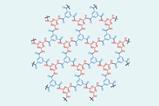Per- and polyfluoroalkyl substances (PFAS) used in many lithium battery electrolytes pose an underappreciated threat to the environment, according to a new report. The researchers behind the finding say that the material must be removed from wastewater streams and call for a more holistic approach to the design of green energy technologies to avoid causing unintentional harms.
As the world struggles to move away from fossil fuels, an ever-greater number of technologies require electrification, and the lithium-ion battery is crucial to this. One of many challenges engineers face when optimising lithium-ion batteries is choosing the electrolyte, and emerging lithium-ion batteries have begun using PFAS such as the ionic liquid lithium bistriflimide. ‘That compound is quite stable thermally as well as very stable chemically – similar to other PFAS,’ explains Lee Ferguson at Duke University in North Carolina, US. This stability is the reason PFAS are often referred to as ‘forever chemicals’.
A research team led by Ferguson and Jennifer Guelfo from Texas Tech University, US, measured the concentration of bistriflimide and other related PFAS, called bis-FASIs, in surface water, tap water, soil, ground water and snow from various locations in the US and Europe. They found that the chemicals were present in almost all samples, with concentrations varying by orders of magnitude.
The highest concentrations in both cases were near a 3M plant producing the chemicals in Minnesota. ‘That doesn’t mean they’re just discharging untreated manufacturing discharge into the Mississippi river,’ says Guelfo, who points out that the 3M site does have a treatment system in place. However, she notes that the team’s findings call into question how effective the system is at removing PFAS from the facility’s waste streams.

The researchers also found that the chemicals were also present in high concentrations in water leaching from landfills – something that is likely to become even more problematic as the world’s mountain of electronic waste grows. At present only 5% of lithium-ion batteries are recycled.
The researchers also assessed the toxicity of the PFAS on aquatic organisms. They found that, in environmentally relevant concentrations, water fleas’ swimming behaviour was altered by bistriflimide’s presence in the water – an accepted sign of neurotoxicity. This effect increased with concentration. The finding adds to the urgency of developing ways to ensure that PFAS are removed from drinking water, the researchers say. Fortunately, the team found that activated-carbon adsorptive treatments, which are conceptually similar to refrigerator water filters, work at least as well at removing bis-FASIs as they do for traditional PFAS.
Looking forward, Guelfo says the work should encourage engineers to collaborate with environmental scientists when developing new technologies. ‘We don’t need to have one person in a vacuum working on battery performance and another person coming behind them saying: “But wait – there are risks associated with this compound,”’ she says. ‘The people and the tools exist to do this in a more holistic fashion.’
Chemical engineer Michael Wong at Rice University in Texas, whose group develops technologies to destroy PFAS, describes the report as ‘a really comprehensive piece of work’. ‘PFAS are everywhere, so on the one hand for them to say that PFAS are found in electronics is not a surprise, and I’m not surprised they’re near manufacturing sites,’ he says. ‘But I think they’ve done an excellent job of identifying a class of PFAS compounds and showing that they affect some organisms.’ He explains that adsorbtive technologies are widely regarded as an unacceptable long-term solution as, when the filters are thrown away, the PFAS may be returned to the environment from landfills, for example. ‘I’m going to use my technologies to see if they work on this stuff, so this is a good paper to inform some of my future work,’ he says.
References
J L Guelfo et al, Nat. Commun., 2024, DOI: 10.1038/s41467-024-49753-5

















No comments yet